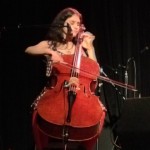Date: May 28, 2013
Venue: Littlefield (NY)
Review by Dawoud Kringle
On an unseasonably cold, and wet, spring night, at Littlefield, a venue in a dark street in Brooklyn, Bell Cycle celebrated the release of their new CD. Bell Cycle is an ensemble led by Isabel Castevelli. Rob Chaimberlain played guitar, drums, electronics; at the same time, mind you.
 Isabel Castevelli is a graduate from Manhattan School of Music, where she earned a Master’s Degree in
Isabel Castevelli is a graduate from Manhattan School of Music, where she earned a Master’s Degree in  Contemporary Music Performance and studied with Fred Sherry. She earned her bachelor degree in music performance from DePaul University, where she studied with Katinka Kleijn and Steve Balderston. Previous teachers include Fred Zlotkin, Danny Morganstern and Myriam Santucci. She has toured and recorded in the US, Europe, Asia, South America and the Middle East with the Mivos Quartet, Diane Cluck, Katie Mullins, Marc Farre, Lewis Lazar, Sasha Siem, J.G. Thirwell’s Manorexia, Diane Cluck, CocoRosie, Ned Rothenberg, Tori Ensemble, Timucin Sahin, Beth Nielsen Chapman, CelloVox, Copal, and ThingNY. She lives in New York City.
Contemporary Music Performance and studied with Fred Sherry. She earned her bachelor degree in music performance from DePaul University, where she studied with Katinka Kleijn and Steve Balderston. Previous teachers include Fred Zlotkin, Danny Morganstern and Myriam Santucci. She has toured and recorded in the US, Europe, Asia, South America and the Middle East with the Mivos Quartet, Diane Cluck, Katie Mullins, Marc Farre, Lewis Lazar, Sasha Siem, J.G. Thirwell’s Manorexia, Diane Cluck, CocoRosie, Ned Rothenberg, Tori Ensemble, Timucin Sahin, Beth Nielsen Chapman, CelloVox, Copal, and ThingNY. She lives in New York City.
Rob Chaimberlain is a Brooklyn-based drummer, guitarist, and vocalist. He performs regularly with a broad range of musicians, dancers, visual artists, yogis and creative types of all kinds. He has played in rock bands, composing music for modern dance companies, backing electro-worldbeat groups, improvising for yoga and dance classes, fronting various acoustic and hard rock ensembles. He’s taught at the Omega Institute, performed at Jazz at Lincoln Center, and most rock venues in NYC. He also collects rare, pre-industrial Eurasian artifacts, and invents his own instruments.
The performance was prefaced by incense burning, and the sound of an electronic shruti filling the air with a C (shades of Terry Riley!) Out of nowhere, samples of voices chanting and wailing flew about, as they were treated with electronic processing. With no warning, a c minor vamp in a 5 beat cycle pummeled its way through the dense aural cloud. They were joined by tabla player. It ended with Isabel chanting/singing.
The next song began with a singalong drum beat (with audience participation that formed the foundation for a pop-ish song. This had a more upbeat feel. They were joined by a drummer, and Steve, Isabel’s fiancé, on vocals.
The next song began with harmonics on the cello, and ballad type chords on guitar. While singing of ships on the sea, the guitar held down the chords and the cello deftly vacillated between harmonics, whole notes, and pizzicato. With the bass drum pounding insistently, and the cello trilling frantically, the song reached a climax, and then settled in a floating end.
Isabel laid her cello aside, and picked up a rabab. After a brief intro, the song started; she altering between bowing and pizzicato. Then Isabel picked up a wood xylophone for a ballad.
For the next song, audience participation in the firm of noise, and farm animal sounds was requested. The sounds from the audience proved a challenge to the musicians, because they wanted to laugh at the ridiculous noises the audience was contributing. This all contrasted with the serious vibe if the song. It was all fun.
Masterfully executed harmonics on cello began the next song. Guitar chords filled the rhythmic framework. A minimal bass drum mimicking a heartbeat complimented the serious lyrics.
What followed was the most energetic song of their repertoire. The guitar and cello drove on relentlessly while the vocal harmonies flew over them. The tabla, drums, and bass rejoined them while the song fought value toy through a maelstrom of rock energies and noise that ended on a coherent harmony.
The last song began with guitar chords that reminds me vaguely if the opening of Blind Faith’s can’t find my way home. But it went nowhere near that, as the cello played sad sounds and Isabel sang of an old love affair.
They did two encores. “Tangerine;” a led zeppelin cover that was requested by someone who contributed to their kickstarter campaign. The second encore was an a capella piece that had several people joining them.
Bell Cycle’s music reminded me of old groups such as Renaissance or Pentangle. Their music has an old world feel, yet fits with today’s independent underground. Chaimberlain’s work on his one man band set up was ingenious and always on point. Castavelli’s work on cello is brilliant. Her training and imaginative use of the cello is a powerful centerpiece for the band’s music; yet it never overshadows the needs of the song. Bell Cycle is a fascinating band.

